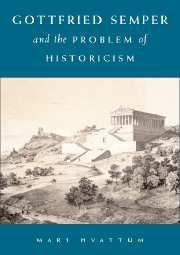Book contents
- Frontmatter
- Contents
- List of Figures
- Prolegomenon
- Introduction – Gottfried Semper: Texts and Interpretations
- PART I TOWARDS A POETICS OF ARCHITECTURE
- PART II PRACTICAL AESTHETICS
- PART III THE APORIAS OF HISTORICISM
- 7 Semper and the “Style of Our Time”
- 8 History and Historicism
- 9 Between Poetics and Practical Aesthetics
- Epilogue
- Notes
- Selected Semper Bibliography
- Bibliography
- Index
9 - Between Poetics and Practical Aesthetics
from PART III - THE APORIAS OF HISTORICISM
Published online by Cambridge University Press: 06 August 2009
- Frontmatter
- Contents
- List of Figures
- Prolegomenon
- Introduction – Gottfried Semper: Texts and Interpretations
- PART I TOWARDS A POETICS OF ARCHITECTURE
- PART II PRACTICAL AESTHETICS
- PART III THE APORIAS OF HISTORICISM
- 7 Semper and the “Style of Our Time”
- 8 History and Historicism
- 9 Between Poetics and Practical Aesthetics
- Epilogue
- Notes
- Selected Semper Bibliography
- Bibliography
- Index
Summary
Chapter 8 examined the intellectual framework of historicism, looking at the way such seemingly adverse tendencies as historical individualism and historical determinism were fused within it. Trying to grasp this ambiguous framework, I drew on Gadamer's notion of the aporias of historicism, by which he pinpointed the inherent tension in historicist thought between romanticism and positivism. This peculiar fusion was made possible by the organic analogy, recasting history as a self-regulating system, complete at every point yet governed by comprehensible laws. The organic paradigm seemed to do for history what it had done for anatomy and linguistics: to allow for a methodical explanation and prediction of historical phenomena, establishing a science of history and historical expressions. This aspiration lies at the heart of nineteenth-century historicism, pointedly defined by Heidegger as history becoming “an object of contemplation for method”.
However, if the aesthetic-organic framework of historicism sheds light on certain ambiguities within Semper's practical aesthetics, it does not illuminate the aspect of Semper's thinking that I have called his poetics; that is, his notion of art as a creative interpretation of praxis. Emphasising the inalienable presence of the past embodied in art, Semper's poetics of architecture presented a mode of history very different from the historicism of style and epoch. Following Gadamer, we may talk about this as Geschichtlichkeit: the inescapable historicity of human existence.
- Type
- Chapter
- Information
- Gottfried Semper and the Problem of Historicism , pp. 175 - 188Publisher: Cambridge University PressPrint publication year: 2004



